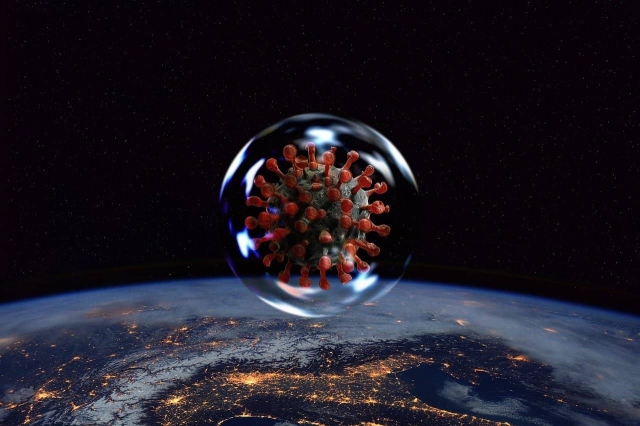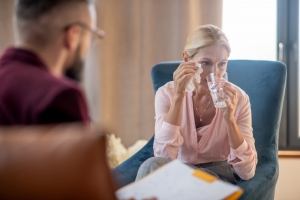The 2019 coronavirus is an infectious disease caused by the SARS-CoV-2 and belonging to the big family of Coronaviridae. These viruses are constantly changing and evolving. It was during one of these mutations that it became able to infect humans.
1. Coronavirus and covid-19, what are they?
Coronavirus belongs to a family of viruses responsible for various infections ranging from the common cold to severe lung infection, with acute respiratory distress.
In the case of the COVID-19 infection, due to a coronavirus called Sars-CoV-2, it is a coronavirus close to SARS, which caused a global epidemic in 2002-2003. But it is contagious at a higher level.
Unlike its predecessors, coronavirus appears to be particularly contagious. It has also been found in many fluids, and biological excretions (secretions from the mouth and nose, blood, stools, urine), which suggests the risk of multiple transmission, especially since all patients infected do not necessarily show symptoms, especially in younger people. In 80% of cases, Covid-19 hardly poses a problem, and the patient heals quickly, without hospitalization.
But in people who already suffer from a chronic disease, immunosuppression, old age, etc. Covid-19 can become complicated and require hospitalization or even resuscitation. Above all, everyone must take their responsibilities and respect the instructions given in the event of a suspected infection or containment measures if the infection is proven.
2. How is coronavirus transmitted?
Coronavirus or SARS-CoV-2 is transmitted from an infected person to an uninfected person by two main routes:
- Direct contact with the infected person or a surface they have contaminated.
- Airborne transmission of the virus via droplets or an aerosol emitted by the infected person.
Droplets (1 µm to 1 mm) are emitted from our mouth and nose when we speak, shout, sing, cough, or sneeze. Aerosols are suspensions of smaller particles (a few nanometers to 100 µm), like the vapor produced by our breathing in cold weather. In reality, there is a continuum between droplets and aerosol, which, in practice, renders the distinction between these two modes of vectorization of the virus artificial.
Concretely, in the absence of a mask, an infected person emits droplets loaded with viruses, the largest of which are deposited by gravity on surfaces in the immediate vicinity. A healthy person can then become infected by touching the contaminated area with their hands and then bringing them to their mouth, nose, or eyes. The virus can persist for several hours on a contaminated inert surface. The duration of its persistence varies depending on the nature of the surface, the surrounding temperature, humidity, and light conditions.
But that's not all: the smaller the diameter of the droplets emitted by the infected person, the more these droplets can be carried away by the ambient air and remain in suspension there. Thus, the virus can accumulate in the indoor air of a poorly ventilated room and lead to its airborne transmission.
3. What are the symptoms of the COVID-19 coronavirus?
The American company Web MD, which provides health information, took up an analysis from the World Health Organization. It was carried out among 55,924 confirmed cases in China to find out more about the virus and its symptoms. Here are the most common signs and the percentage of people who have suffered from them, according to the study:
- Fever: 88%;
- Dry cough: 68%;
- Fatigue: 38%;
- Sputum or thick phlegm from the lungs: 33%;
- Shortness of breath: 19%;
- Bone or joint pain: 15%;
- Sore throat: 14%;
- Headache: 14%;
- Chills: 11%;
- Nausea or vomiting: 5%;
- Stuffy nose: 5%;
- Diarrhea: 4%;
- Blood cough: 1%;
- Swollen eyes: 1%.
Related: The impact of Covid-19 on the environment, economy and social life
4. Coronavirus; diagnosis
In the case of suspected coronavirus infection, people have to call their attending physician or a doctor by teleconsultation if they have breathing difficulties or discomfort, but especially not to move.
The diagnostic test for the coronavirus is subject to medical prescription. Carried out in a hospital or a city laboratory, it consists of a nasopharyngeal sample from the upper part of the nose using a long cotton swab. The setting up of the test makes it possible to know whether the sampled substance is with a virus or not. The patient receives the results within 24 to 48 hours. In the event of a positive test, the patient must stay at home.
5. Coronavirus; the people concerned
Anyone can catch the Sars-CoV-2 because this virus is new; our immune system does not recognize it and cannot protect us from it. However, it is especially some people who are at higher risk for serious complications. We may be concerned in the following cases:
- An age of over eighty,
- High blood pressure,
- Diabetes
- A pre-existing lung disease,
- Heart disease,
- Cancer under treatment
- Immunosuppression,
- A pregnancy in progress (according to known infections by other coronaviruses, for a pregnant woman, there will undoubtedly be a risk of miscarriages and premature deliveries).
- More generally, any fragile person.
6. What is the treatment for the coronavirus?
To this day, there is no specific treatment for CoVid-19. Treatment of cases is only symptomatic (treatment of fever, congestion, or possible pain). Several treatments are evaluating in conjunction with the WHO to use them against the Coronavirus CoVid-19. Dozens of already existing antiviral molecules, such as chloroquine against malaria, lopinavir, and ritonavir against HIV, and ribavirin against hepatitis C, are being tested. Lopinavir and arbidol, used in Russia and China against influenza, appear to be showing particularly satisfactory results, according to one study.
Several teams of researchers around the world are currently working on the development of a vaccine.
7. Prevention from coronavirus
To prevent the spread of coronavirus, follow these recommendations:
- Wash your hands frequently. Use soap and water or a hydroalcoholic solution.
- Stay away from anyone who coughs or sneezes.
- Wear a mask when physical distancing is not possible.
- Avoid touching your eyes, nose, or mouth.
- Cover your mouth and nose with the bend of your elbow or with a tissue when you cough or sneeze,
- Stay home if you are not feeling well.
- See a healthcare professional if you have a fever, cough, and have difficulty breathing.
- Notify the healthcare professional by phone beforehand. He will be able to direct you quickly to the appropriate health establishment. This protects you and prevents the spread of viruses and other infections.
- Masks
Masks can help prevent people who wear them from spreading the virus to other people. Wearing a mask alone does not protect against COVID-19. You should keep physical distancing and hand hygiene measures. Follow the advice of local health authorities.
- What is psychological well-being about?
- Education and COVID; the impact of COVID pandemic on education
- All About Lung Cancer; Symptoms, Causes, and different Treatments
Originally published on Live Positively.






